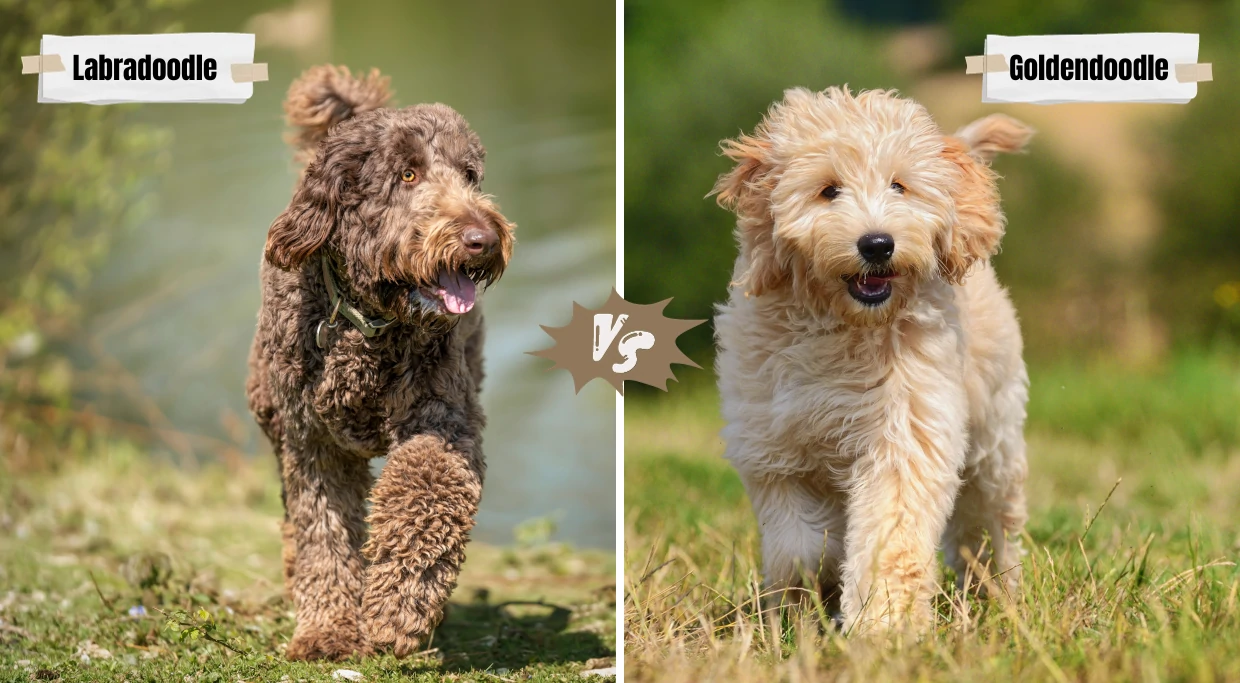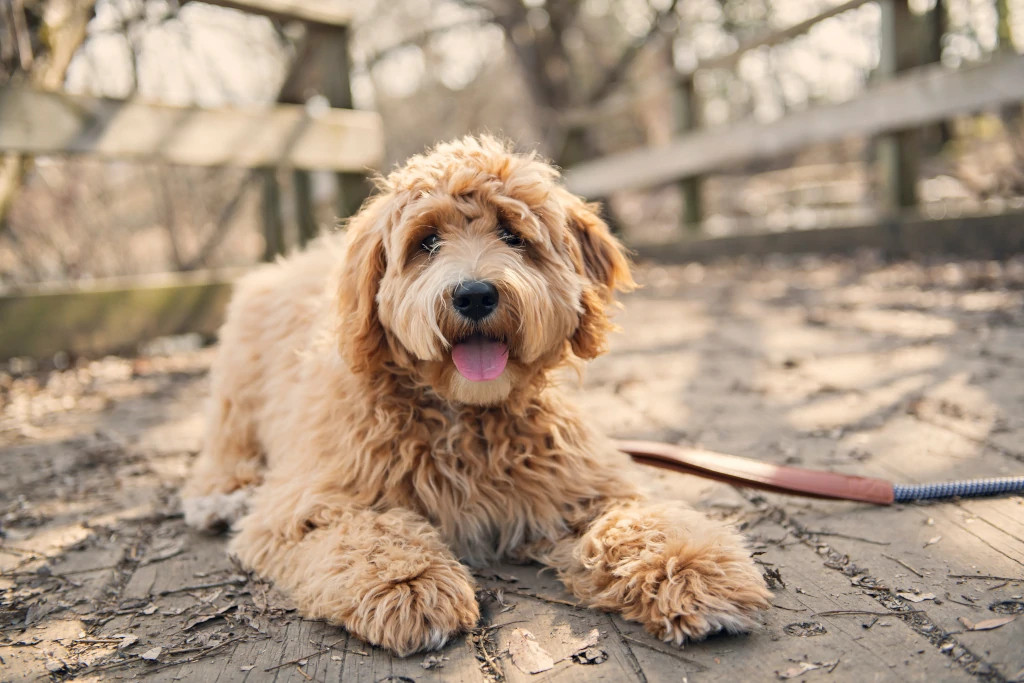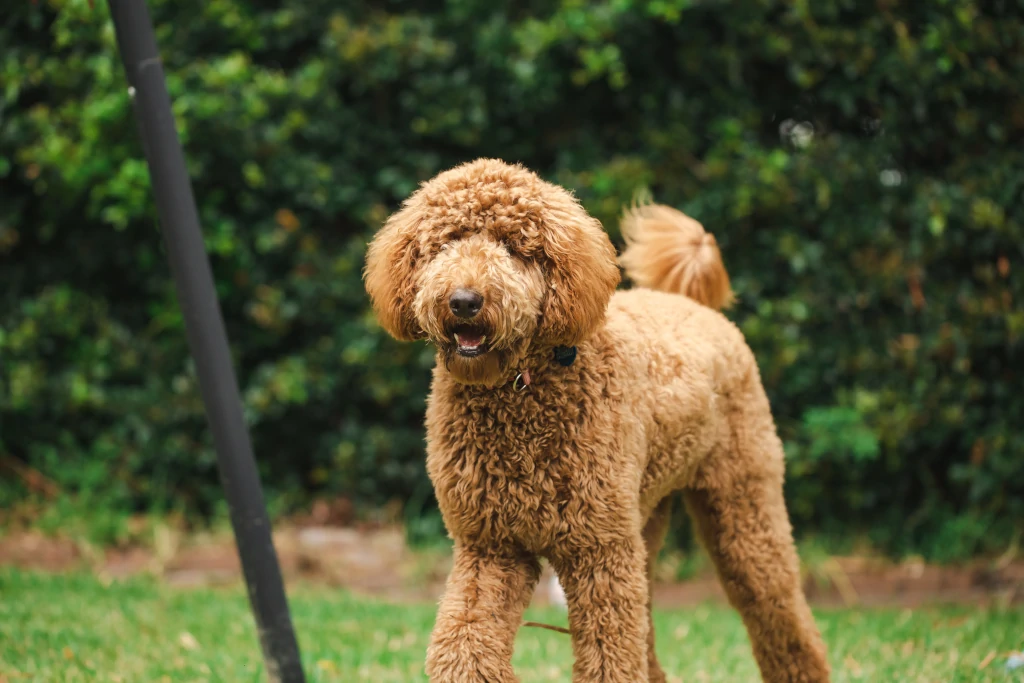
In the world of designer dog breeds, two names have consistently risen to the forefront: the Labradoodle and the Goldendoodle. Both breeds, renowned for their friendly dispositions, low-shedding coats, and adorable looks, have captured the hearts of many.
With a perfect blend of intelligence from the Poodle and the loyalty of the Labrador Retriever or Golden Retriever, these two poodle mixes have quickly become favorites among families, celebrities, and dog enthusiasts alike.
But how do you distinguish between the two? And more importantly, which one aligns with your lifestyle?
This comprehensive guide dives deep into the Labradoodle vs. Goldendoodle debate, offering insights into their histories, temperaments, and much more, helping you decipher the nuances and make an informed choice for your next furry family member.
| Breed Comparison | Labradoodle | Goldendoodle |
|---|---|---|
| Weight | Up to 65 pounds | Up to 70 pounds |
| Height | 14 - 24 inches | 14 - 24 inches |
| Size | Mini, Medium, Standard | Mini, Medium, Standard |
| Temperament | Intelligent, friendly, playful | Intelligent, gentle, outgoing |
| Trainability | 4.0 out of 5.0 stars4.0 | 4.0 out of 5.0 stars4.0 |
| Energy Level | 4.0 out of 5.0 stars4.0 | 3.0 out of 5.0 stars3.0 |
| Life Expectancy | 10 - 14 years | 10 - 15 years |
| Shedding | 2.0 out of 5.0 stars2.0 | 2.0 out of 5.0 stars2.0 |
| Hypoallergenic | Yes | Yes |
| Puppy Costs | $1,000 - $4,000 | $1,000 - $3,000 |
History and Origins
Labradoodle

The tale of the Labradoodle begins in Australia during the 1980s. It was Wally Conron, a breeding manager for the Royal Guide Dog Association of Australia, who first intentionally crossbred a Labrador Retriever and a Poodle.
The purpose? To produce a guide dog that possessed the intelligence and trainability of the Labrador Retriever and the hypoallergenic coat of the Poodle, making it suitable for people with allergies.
While the breed initially faced skepticism, its undeniable charm and suitability as both a guide and companion dog led to its rapid rise in popularity worldwide.
Goldendoodle

This lovable breed’s origin traces back to the 1990s, a decade after the Labradoodle made its debut.
Like the Labradoodle, the Goldendoodle, also known as the Groodle, was bred to merge the best qualities of two breeds: the gentle temperament of the Golden Retriever and the low-shedding, hypoallergenic coat of the Poodle.
Though commonly used as an alternative to the hypoallergenic guide dog, Labradoodle, its inception was less about creating a service dog and more about developing a family-friendly pet that was both affectionate and allergen-friendly.
Today, the Goldendoodle stands as one of the most sought-after doodle dogs, known for its sociable nature and endearing appearance.
| Attribute | Labradoodle | Goldendoodle |
|---|---|---|
| Origin | Australia, 1980s | United States, 1990s |
| Initial Purpose | Guide dog for those with allergies | Family pet with hypoallergenic properties and an alternative to the Labradoodle |
| Parent Breeds | Labrador Retriever and Poodle | Golden Retriever and Poodle |
** Comparison Table: Key Differences in History and Origins
Physical Differences: Labradoodle vs. Goldendoodle
The Labradoodle and Goldendoodle, both marvels of hybrid breeding, stand out with their distinct fur patterns and charismatic charm. A defining aspect of their size is the type of Poodle parentage – Standard, Klein (Medium), Miniature, or Toy – which is pivotal in determining their stature.
That said, Goldendoodles typically command a slightly larger presence than Labradoodles. A fully-grown Goldendoodle can weigh up to 70 pounds, while a Labradoodle of the same age and care might weigh just a tad less, around 65 pounds.
In the realm of coat colors, Goldendoodles predominantly parade in shades of golden hues, caramels, reds, cream, and apricots. In contrast, Labradoodles present a broader spectrum of colors, ranging from black, white, yellow, chocolate, caramel, red, cream, apricot, parti, and more.
When observing their fur texture and length, both poodle mix breeds exhibit low shedding and a tendency for curls.
However, the Labradoodle, with Labrador genes, often sports a slightly shorter, more defined fur, leaning towards a less curly finish. The Goldendoodle, influenced by the Golden Retriever’s lineage, flaunts longer, denser, and more spiral curls, giving it a fluffier appearance in comparison.
You May Also Like: Different Types Of Poodles
| Attribute | Labradoodle | Goldendoodle |
|---|---|---|
| Weight (Mini) | 20 - 30 pounds | 25 - 35 pounds |
| Weight (Medium) | 31 - 50 pounds | 36 - 55 pounds |
| Weight (Standard) | 51 - 65 pounds | 56 - 70 pounds |
| Height (Mini) | 14 - 17 inches | 14 - 17 inches |
| Height (Medium) | 18 - 20 inches | 18 - 20 inches |
| Height (Standard) | 21 - 24 inches | 21 - 24 inches |
| Fur Length & Texture | Slightly shorter, textured (fleece or wool) | Longer, dense with prominent curls |
| Inherited Fur Traits | From Labrador: shorter, defined | From Golden Retriever: longer, denser, curly |
** Comparison Table: Key Differences in Physical Appearance
Temperament and Personality: Labradoodle vs. Goldendoodle
When exploring the nature of Labradoodles and Goldendoodles, both breeds undeniably shine with their affable personalities, making them prime choices for families, singles, and seniors alike.
However, discerning the subtle nuances in their temperament and behavior can aid prospective owners in understanding which breed aligns best with their lifestyles.
Labradoodle

Inherited from their Labrador parent, Labradoodles often exhibit an enthusiastic zest for life.
They are known for their playful exuberance and unyielding loyalty to their human counterparts. Their intelligence, courtesy of the Poodle genes, makes them quick learners, adept at both obedience and more advanced tricks.
However, they can occasionally exhibit a tad bit of stubbornness, which requires consistent training methods. Their affable nature means they usually mingle well with children and other pets.
You May Also Like: Why Do Dogs Dig?
Goldendoodle

Goldendoodles, with the gentle temperament of the Golden Retriever, are renowned for their mild-mannered and placid disposition.
They radiate warmth and are often perceived as the “gentle giants” of the doodle world. Their affectionate demeanor makes them outstanding companions, particularly for families with kids.
While they’re equally intelligent, they often approach learning with a slightly more relaxed attitude than the Labradoodle. Their sociability extends to both humans and other animals, making them excellent candidates for multi-pet households.
| Attribute | Labradoodle | Goldendoodle |
|---|---|---|
| General Temperament | Energetic, playful, loyal | Gentle, affectionate, relaxed |
| Interaction with Kids | Friendly and playful | Extremely gentle and patient |
| Multi-Pet Household | Generally amicable with other pets | Exceptionally sociable with other animals |
** Comparison Table: Key Differences in Temperament and Behavior
Energy Levels: Goldendoodle vs. Labradoodle
One significant aspect to consider when adopting a canine companion is their energy level. This can influence daily routines, exercise needs, and even compatibility with certain lifestyles.
Labradoodle

Deriving from the energetic Labrador Retriever and the intelligent Poodle, the Labradoodle is a bundle of vitality. These dogs thrive on activity and often have bursts of energy that require regular outlets.
Whether it’s a game of fetch, a run in the park, or agility training, Labradoodles benefit from consistent and varied physical activities. This spirited demeanor makes them great partners for active individuals and families, but they might pose a challenge for those who prefer a more sedate lifestyle.
You May Also Like: Canicross Training Plan: From Couch Potato to 5K Runner!
Goldendoodle

With its Golden Retriever lineage, the Goldendoodle possesses a moderate to high energy level but usually exhibits a more even-keeled disposition than the Labradoodle.
While they absolutely enjoy playtime, long walks, and interactive sessions, they can also appreciate relaxed moments and are slightly more adaptable to quieter environments. Their balanced energy means they fit well in various households, from active families to more laid-back settings.
You May Also Like: Tips To Taking Your Dog Out On A Bike Ride
| Attribute | Labradoodle | Goldendoodle |
|---|---|---|
| Energy Level | High | Moderate to high |
| Exercise Needs (Per Day) | 2 hours | 1 to 2 hours |
| Best Suited For | Active individuals or families | A broader range of lifestyles, including quieter settings |
** Comparison Table: Key Differences in Energy Levels
Training: Goldendoodle vs. Labradoodle
Labradoodles and Goldendoodles, both stemming from intelligent lineage, are naturally adept at picking up new commands and tricks. With their intuitive nature, they are often lauded for their training receptiveness.
Labradoodle

Being a blend of Labrador Retrievers and Poodles, Labradoodles naturally inherit a sharp intellect.
Labrador Retrievers are known for their obedience and eagerness to please, making them one of the preferred breeds for various roles, from service dogs to search and rescue missions. On the other hand, Poodles are renowned for their intelligence, often ranking among the top few in dog intelligence tests.
Consequently, Labradoodles are generally responsive to training.
However, this mixed breed can sometimes display a streak of stubbornness. So, it’s important to be patient and consistent during the training process. Also, early socialization is pivotal to harnessing their potential fully.
You May Also Like: 7 Popular Types Of Dog Training
Goldendoodle

Goldendoodles, being a mix of Golden Retrievers and Poodles, are also known for their intelligence.
Golden Retrievers, with their gentle disposition, are exceptionally trainable and have historically been used in roles ranging from therapy dogs to sniffers at airports. Combined with the Poodle’s smarts, Goldendoodles emerge as one of the relatively easier breeds to train.
Like Labradoodles, Groodles benefit greatly from early socialization and consistent training. One thing, though, is that they tend to be rather sensitive. So, it’s best to use positive reinforcement-based training methods to get the best out of them.
You May Also Like: Train Your Dog Like A Pro With Clicker Training!
| Attribute | Labradoodle | Goldendoodle |
|---|---|---|
| Intelligence | High | High |
| Trainability | High | High |
** Comparison Table: Key Differences in Training
Health and Lifespan
Labradoodle

Originating from the Labrador Retriever and the Poodle, Labradoodles generally enjoy a healthy lifespan between 10 and 14 years, contingent upon proper care, diet, and exercise.
While they’re robust, they aren’t without potential health concerns. Commonly, they can be prone to hip dysplasia, epilepsy, eye conditions like progressive retinal atrophy (PRA), and, occasionally, certain heart conditions.
Regular veterinary check-ups, a balanced diet, consistent exercise, and getting your puppy from a reputable breeder can aid in mitigating these concerns.
Goldendoodle

Groodles, with genes from the Golden Retriever and the Poodle, typically have a lifespan that spans 10 to 15 years, depending on their overall health and care.
While they share some health concerns with Labradoodles, such as hip dysplasia and epilepsy, they might also be predisposed to developing cancers. As always, regular vet visits, a proper diet, and an active lifestyle can play pivotal roles in ensuring their health and longevity.
| Attribute | Labradoodle | Goldendoodle |
|---|---|---|
| Average Lifespan | 10 to 14 years | 10 to 15 years |
| Overall Health | Generally healthier than Goldendoodles | Healthy |
** Comparison Table: Key Differences in Health and Lifespan
Dietary Needs and Considerations

The amount you serve your doodle isn’t a one-size-fits-all scenario; it’s contingent on various determinants, including their size, age, activity levels, health, and the specific dog food brand you opt for.
While it’s challenging to pinpoint an exact measurement due to these variables, there are general guidelines to keep in mind. Toy-sized doodles naturally consume significantly less compared to their larger counterparts. A large doodle might require anywhere between two to three cups of food daily, whereas petite toy-sized ones might only nibble on half a cup.
The quality of food you provide is pivotal in their health and satisfaction. So investing in the best quality kibble that aligns with your budget is always best. These premium dog foods usually offer a harmonious blend of essential nutrients, ensuring your furry friend not only enjoys their meals but thrives on them.
Additionally, selecting a food tailored to your pet’s specific age and size is crucial to cater to their individual dietary needs.
Both doodles are known for their hearty appetites, but Labradoodles tend to display a more voracious inclination toward food, often being the more voracious of the duo. As delightful as it may be to indulge them, regulating their portions and maintaining a balanced diet is vital to stave off potential obesity.
You May Also Like: 14 Possible Reasons Your Dog Won’t Eat
| Attribute | Labradoodle | Goldendoodle |
|---|---|---|
| Food Intake | Variable, with larger breeds eating up to 3 cups daily | Depending on size, up to 3 cups for larger breeds |
| Appetite Tendency | Typically more eager and food-driven | Hearty appetite, but slightly less voracious |
| Obesity Risks | Higher due to their immense love for food | Monitor portions to ensure a balanced weight |
** Comparison Table: Key Differences in Diet
Grooming Needs: Labradoodle vs. Goldendoodle
Labradoodle

Bearing the genes of both the Labrador Retriever and the Poodle, Labradoodles exhibit a diverse range of coat types, including fleece, wool, and hair. While they are touted as low- to non-shedding, the degree can vary based on their genetics.
Regular brushing, at least a few times a week, is vital to prevent matting and tangles. Depending on their coat type, they may need professional grooming every 6-8 weeks. Their ears should be checked regularly for debris and wax build-up, and their nails should be trimmed every 2-4 weeks.
You May Also Like: Best Dog Nail Grinders
Goldendoodle

Goldendoodles, a blend of Golden Retriever and Poodle genetics, typically sport a wavy to curly coat that’s dense. Their low- to non-shedding nature appeals to those with mild allergies.
However, they require consistent grooming. Brushing them multiple times a week helps keep their fur free from tangles and mats. Professional grooming sessions, much like the Labradoodle, are recommended every 6-8 weeks. Routine ear checks and monthly nail trims are also essential for their well-being.
You May Also Like: Best Dog Ear Cleaning Solutions
| Attribute | Labradoodle | Goldendoodle |
|---|---|---|
| Coat Type | Fleece, wool, or hair | Curly, wavy, or straight |
| Shedding Level | Low- to non-shedding | Low- to non-shedding |
| Brushing Frequency | 2 - 3 times a week | 2 - 3 times a week |
** Comparison Table: Key Differences in Grooming and Maintenance
Puppy Price: Goldendoodle vs. Labradoodle
Labradoodle

Originating from the blend of Labrador Retrievers and Poodles, Labradoodles have seen a surge in demand over the years. Factors like the puppy’s size, lineage, the breeder’s reputation, and even the geographical location can influence the price.
Generally, potential Labradoodle owners can expect to pay anywhere between $1,000 to $4,000, although prices can go higher for premium lineage or specific colorations.
Goldendoodle

Being a mix of Golden Retrievers and Poodles, Goldendoodles have also captured the hearts of many dog enthusiasts. Their price varies based on similar factors as Labradoodles.
Typically, a Goldendoodle puppy costs slightly less than a Labradoodle puppy, with prices ranging from $1,000 to $3,000. Similarly, special attributes like a unique coat color, a renowned lineage, or even a specific coat type like wavy or curly (because of its low-shedding properties) can push the price higher.
| Attribute | Labradoodle | Goldendoodle |
|---|---|---|
| Average Price | $1,000 - $4,000 | $1,000 - $3,000 |
** Comparison Table: Key Differences in Puppy Price
Which Breed is Better? Goldendoodle or Labradoodle?
Choosing between a Labradoodle and a Goldendoodle can indeed be a delightful dilemma. Both breeds shine with their individual quirks, playful dispositions, and undeniable charm. While they share many similarities, their differences in aspects like physical appearance, temperament, and even historical lineage make each breed unique in its own right.
When deciding on the best fit for your family, lifestyle, and preferences, it’s crucial to consider the traits that matter most to you. Is it the lively personality of a Labradoodle that captures your heart, or the gentle demeanor of a Goldendoodle?
Whether it’s the Labradoodle’s slightly varied coat colors or the Goldendoodle’s tendency to have longer fur, each has its appeal.
At the end of the day, regardless of your choice, both breeds promise a loyal companion, a playful family member, and an affectionate furry friend. Your decision will pave the way for countless joyful moments, shared adventures, and cherished memories with your four-legged partner.
Frequently Asked Questions About Labradoodle vs. Goldendoodle
Q1: Which breed is better for families with young children, Labradoodle or Goldendoodle?
A: While both breeds are known for their gentle and friendly nature and make great family dogs, Goldendoodles tend to have a slightly calmer temperament and may be the better option for families with young children.
Q2: Are Labradoodles and Goldendoodles hypoallergenic?
A: No. No dog breed is truly hypoallergenic. However, both the Labradoodle and Goldendoodle are known for producing fewer allergens compared to many other breeds, so they are often referred to as being “hypoallergenic,” making them a good choice for individuals with allergies.
Q3: How do Labradoodle and Goldendoodle coats differ?
A: Although both breeds can have curly or wavy coats, Labradoodles often have a wider range of colors and might have slightly less curly fur due to their Labrador genes. Goldendoodles typically have longer fur, influenced by the Golden Retriever parent.
Q4: Which breed sheds less, the Labradoodle or the Goldendoodle?
A: The exact amount can vary depending on the specific genetics of each individual dog. Generally, Goldendoodles with more Poodle genetics (like F1B or F2) might shed less than Labradoodles.
Q5: What are F1, F1B, and F2 in Labradoodles and Goldendoodles that people often talk about?
A: F1, F1B, and F2 refer to the different generations of crossbreeds. F1: First generation, a purebred Golden Retriever or Labrador mated with a purebred Poodle. F1B: An F1 Goldendoodle or Labradoodle bred back with a Poodle. This generation often has more Poodle-like characteristics, including a higher chance of having hypoallergenic fur. F2: Second generation, produced by mating two F1 dogs.
Q6: Do they have similar temperaments?
A: Both breeds are known for their friendly and affectionate nature. Labradoodles might be slightly more reserved, while Goldendoodles are often perceived as more sociable and adaptable.
Q7: Which breed is more popular in the US? Goldendoodle or Labradoodle?
A: The exact rankings are unknown as they are both not recognized by the American Kennel Club (AKC). However, since Labradors are America’s most popular breed and Labradoodles have been around slightly longer, Labradoodles are likely more popular than Goldendoodles in the US.

